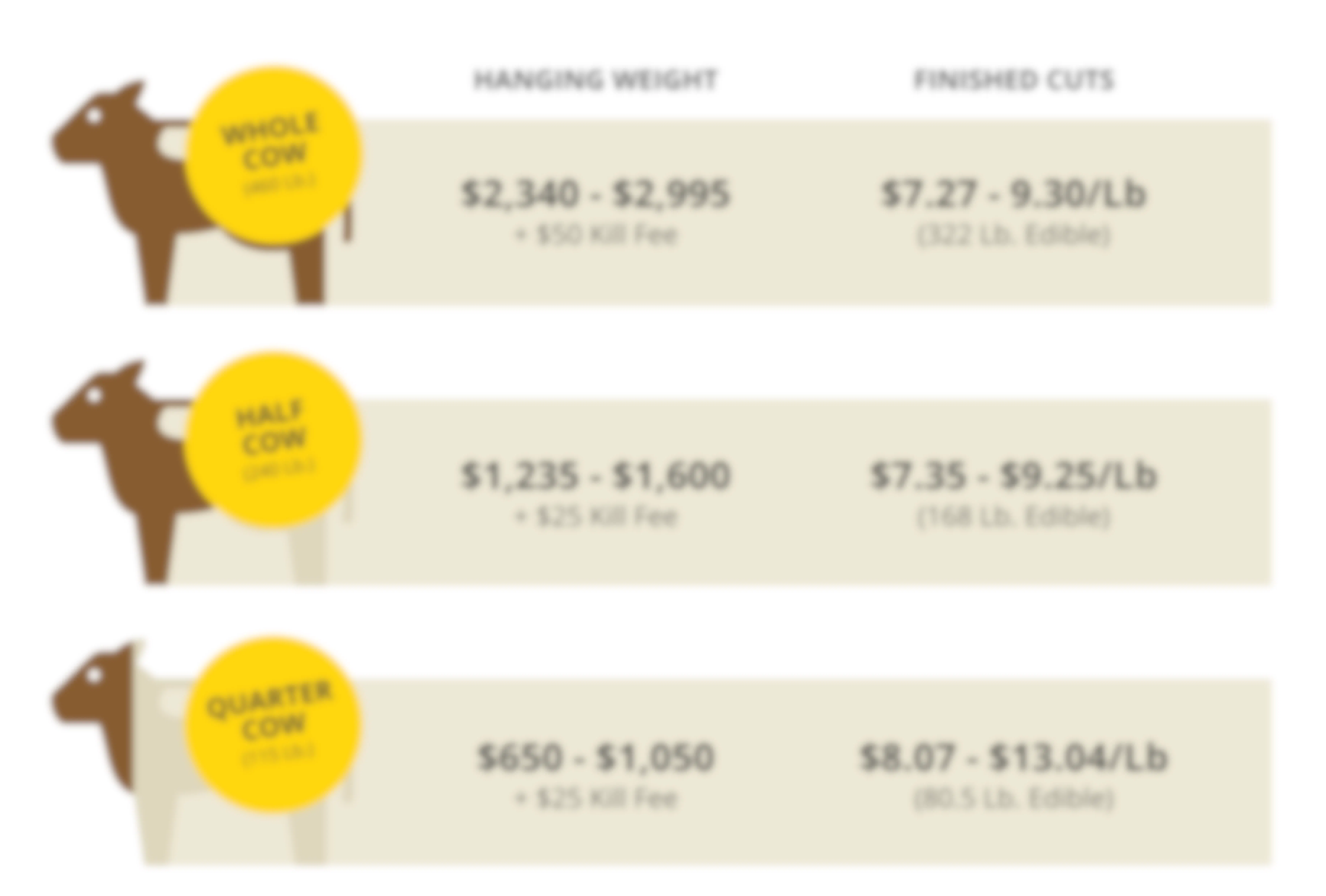Many homesteaders are looking for ways to cut costs while still getting all the food they need as grocery store prices continue to soar. How much meat is half a cow? How many steaks are in a cow? In particular, the cost of meat can be prohibitively expensive.
We stocked our freezer with a half cow (or half beef, if you want to sound knowledgeable) this past summer.
Even though we had long wanted to stock up on meat, it was challenging to determine how to go about doing so and what to anticipate in terms of cost and the amount of beef we would receive.
In essence, we had no idea what we were doing or what to anticipate. We finally stocked our freezer with an abundance of beef on a tight budget after doing a lot of research and locating the ideal supplier!
What we learned about how much meat you get from a cow, how many steaks are in a cow, and how much meat is in a half cow is as follows.
When it comes to beef price per pound, you must calculate prices based on hanging weight.
When you purchase a half cow, you will receive a side of the animal that has been cut in half down the middle, not the front or back. Going with a quarter cow is more of a gamble, and you typically have fewer options. Therefore, if you want to purchase guaranteed cuts of meat, a quarter cow is not for you.
Why does it matter when we talk about buying a cow, and what is “hanging weight” and how is that different from the average weight of a cow?
The price per pound listed on a farm’s website when you are looking to purchase a cow is based on the hanging weight, which refers to the unfinished cuts of meat on a cow. In other words, you shouldn’t eat the cow’s entrails, hooves, etc. , is still factored into the price.
So let’s discuss determining prices using hanging weight and fees. These prices will be set by your neighborhood farm; since they depend on a wide range of variables, they are only estimates:
- Half- or full-cow prices: $5 – $10 per pound
- Processing fee: $0.50 per pound
- Kill fee: $50
How to calculate the hanging weight beef price per pound for a full 460-pound cow:
- $5 price per pound + $0. 50 per pound processing fee = $5. 50 per pound.
- $5. 460 pounds x $0.50 per pound = $2,530 for hanging weight.
- Add a $50 kill fee
- Total fee: $2,580
- Divide the total fee by 460 pounds
- Final Price: $5.60 per pound hanging weight
Expect to pay an average price of $8.01 for finished cuts of beef.

The beef you eat is actually processed and packaged as “finished cuts.” You can use this number to compare prices to items you might purchase at a grocery store.
I%E2%80%99ve found that you%E2%80%99ll get an average of 60 %E2%80%93 80% of the hanging weight in your finished cuts This means you%E2%80%99ll lose 20 %E2%80%93 40% of the cow (and nobody is crying too hard about this; it%E2%80%99s the head and entrails)
More math (stay with me): Using 30% as an average loss amount, here%E2%80%99s how to calculate your hanging weight full beef price per pound against your new lower quantity of meat
Calculating the finished cut weight:
- 460 pounds hanging weight x . 30 loss = 322 pounds finished cut weight.
- By multiplying the $2,530 hanging weight total fee by 322 pounds, you get $8. 01 per pound finished cut weight.
A full cow costs $8 per pound for finished cuts. 01 is the number you’ll use to compare to the prices at the grocery store. Speaking of which ….
Only compare your cow price with organic, grass-fed grocery store beef (or dry-aged!).
You will receive grass-fed, organic, and regional meat when you purchase a cow. So you have to create an apples-to-apples comparison. (Yes, you can purchase a grain-fed cow as well; it is less expensive.) But since the majority of nearby ranches market grass-fed cattle, we’ll only focus on that. ).
Because buying grass-fed or organic beef at the supermarket is expensive, you’re reading this article to learn how to purchase a half cow or more. Now let’s compare the cost of organic, grass-fed beef in grocery stores to the cost of half-cow finished cuts.
- Half-cow finished cut: $8.17 – $15.31 per pound
- Kroger: $7.99 – $10.49 per pound
- Half-cow finished cut: $8.17 – $15.31 per pound
- H-E-B: $13.47 per pound
- Half-cow finished cut: $8.17 – $15.31 per pound
- Sprouts Market: $21.99 per pound
- Half-cow finished cut: $8.17 – $15.31 per pound
- Kroger: $22.40 – $32 per pound
- Half-cow finished cut: $8.17 – $15.31 per pound
- Walmart: $20.82 per pound (for grain-fed)
Pay about $8.20 per pound for expensive cuts of meat like filet mignon (that’s $14 per pound in savings!).
While the cost of ground beef is comparable to that of groceries, purchasing a cow can result in significant savings on cuts like steaks and roasts.
Ranchers offer a lump sum price based on the hanging weight of the cow or half cow, which is why.
Different cuts of meat are not differentiated when dividing it by price per pound. Meaning you’re getting around $8. Ground beef costs $20 per pound, or about the same as at the grocery store, but you also get $8 back. 20 per pound for strip steak. That is about $14 less than the grocery store price!.
Therefore, if you enjoy steak or roast beef, investing in a cow is definitely a good investment.
Buying a whole cow or half a cow (not a quarter cow) will get you the best deal.
When you compare the price per pound for finished cuts and hanging weight, a whole or half cow is comparable in cost.
However, a quarter cow costs between $8 and $12 more than both. 48 – $15. 62 per pound. That’s $0. 47 – $0. Choosing a quarter cow will cost you 79 cents more per pound.
Even if you can’t afford a whole or half cow (or don’t anticipate eating that much meat), the cost is still less than what you’d pay at the grocery store. But avoid the quarter cow if you want to get the best value possible.
Where you live in the U.S. determines how much your cow costs.
Where you live has an impact on the cost of purchasing a cow, and “local” doesn’t always mean the least expensive option.
According to the USDA National Monthly Grass Fed Beef Report, if you live in the Central U.S., you’ll pay the most. Why? The cost reflects the effort it takes to produce grass-fed beef. In the midwest, flat areas of land are prioritized for crops like corn. Compare this with the topography of the western U.S., which is more mountainous, restricting what sorts of crops can grow. In the west, ranchers can graze cows on hills or land that otherwise isn’t useful, agriculturally speaking.
Moreover, a cow you purchase in the Central regions of the United S. even if it has been fed grass, will likely be finished on grain to make it more affordable for ranchers. Although this isn’t necessarily a bad thing, you should be aware of what you’re getting
The good news is you might have options. If you reside in the Central U consider purchasing your cow from a less expensive region. S. Of course, you’ll need to factor in the cost of driving to get it, but occasionally, you might be able to save money. Calling around to compare prices outside of your area is worthwhile.
You won’t get a guarantee on the lean fat percentage of your ground beef.
Most farms won’t let you choose the amount of lean fat in your ground beef because doing so would necessitate a verification process, which many smaller businesses aren’t interested in.
Your ground beef will be between 70/30 and 80/20. Ask the butcher to refrain from trimming the fat from the meat cuts as much as they would otherwise if you want your beef to be closer to the 70/30 ratio. Ask for a closer trim if you want ground beef that is more lean. However, be aware that you might end up paying slightly more because it will take them longer to make careful cuts.
Another choice would be to ask the butcher to avoid adding the fat back into the ground beef when they grind it. Talk to your butcher to see what your options are.
Store your side of beef in the freezer for up to one year.

Before the cheap, grass-fed, humanely raised beef goes bad, make sure you’re ready to eat it all.
If it’s vacuum-sealed and kept in a chest freezer, you have a year to consume it. Calculate how much meat you’ll require based on the number of people in your family and how much you’ll need to consume each week.
If a half cow averages 230 pounds of hanging meat, then the finished cuts of meat weigh between 144 and 185 pounds. Accordingly, a family of four would have to consume three to four pounds of beef each week to consume all the meat in a year.
Be willing to eat all cuts of meat on a cow in order to make buying a cow worth your while.

When you buy a whole cow, you really are buying the whole cow. Different parts of the cow yield different kinds of meat.
So purchasing a side of beef isn’t a good idea if you only plan to grill T-bone steaks or use ground beef. A half-cow purchase typically includes:
- Tenderloin Steaks (Filet Mignon)
- Ribeye Steaks
- NY Strip Steaks
- Sirloin Steaks
- London Broil Steaks
- Flank, Skirt & Hanger Steaks
- Short Ribs
- Shoulder / Rump Roasts
- Chuck Roasts
- Briskets
- Shanks (soup bones)
- Liver
- Stew Meat
- Ground Beef
- Top & Bottom Round Roasts
Don’t have the freezer space for a whole or half cow? Get select cuts of beef directly from a farm.

For farm-fresh meat, you don’t have to purchase the entire animal. However, purchasing steaks and roasts à la carte will cost more.
You will pay more at a farm when purchasing particular cuts of meat than you would at a grocery store. Steaks and roasts will be more expensive than ground beef. This can be a great choice if you only want ground beef. But if you want steaks and roasts, it’ll get spendy.
1 How do I find out how to buy a cow near me?
Look into tools and websites that can connect you with a nearby farm.
To find a farm close to you, use these websites or contact your neighborhood farmers’ market for more details:
1 Ask your rancher if they accept EBT.
Oregon Valley Farms located in my area takes EBT. Unfortunately, they don’t ship nationwide, but it’s an example of a rancher willing to take this form of payment.
Never hurts to ask!
That’s all I’ve got. What are your best suggestions for buying a cow? Do you buy a whole cow with friends or just a half? Let me know in the comments. AccountHot amazon Deals.

Latest Brags from the CommunityGraph
How Much Meat is a Half Beef? Explained in 3 Minutes!
FAQ
Is buying half a cow worth it?
In the long run, it is definitely worthwhile to purchase half a cow. If the vacuum-sealed package is not compromised or the meat is not defrosted, it can last for up to two to three years.
Is buying a 1 4 beef worth it?
Going with a quarter cow is more of a gamble, and you typically have fewer options. Therefore, if you want to purchase guaranteed cuts of meat, a quarter cow is not for you.
How much beef is a half?
When you purchase a half cow, you will receive between 75 and 100 lbs of ground beef, along with the remainder being roasts, steaks, and other cuts like brisket, ribs, stew meat, soup bones, and organ meats (liver, heart, and tongue). ).
How much does a 1 4 cow typically cost?
A quarter of beef will cost between $1240 and $1400 in total and produce 110 to 130 pounds of meat. Typically, a quarter of beef requires 4 cubic feet of freezer space. The price is an all included $6. 20 per pound on the hanging weight, which ranges from 200 to 225 pounds on average.
